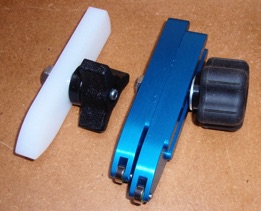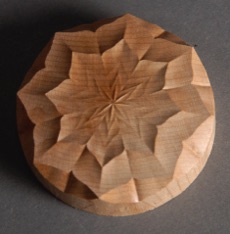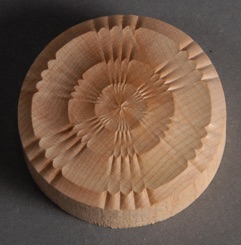
Colvin Tools is now producing and selling rosettes.
Rosettes work on both the original and updated MDF rose engine lathes.
Visit Colvin Tools' Rosettes for the MDF Rose Engine Lathe page to see all the designs.
Last updated: August 2022
Here are photos of the double rubbers and the current rosettes available for the MDF rose engine...
The double rubbers with ball-bearing tips, shown next to the single plastic rubber included with the kit. The double rubbers stack and slide independently. In addition to running more smoothly over complex rosette profiles, the double rubbers also allow rubbing on two rosettes at a time, creating compound patterns as seen here, a combination of the Oval and Sin-48 rosettes:




“The Centerfold” of the original AAW article shows nine patterns all created using just the features of the lathe and only one of the two kit rosettes (Plain-4 & Sin-24) at a time. All of the rosettes includes a series of “phasing holes” specific to the geometry of the rosette. Moving the phasing pin from one hole to another changes the phase of that particular rosette for subsequent cuts.
The lathe also includes a wedge shaped “fading stop” which, when engaged, “replaces” the rosette’s pattern with a portion of a circular cut. This is hard for new turners to grasp, but once you see it it makes a lot more sense. The middle pattern in the bottom row is a simple example of fading on the Sin-24 rosette, leaving behind only the peaks of the sine-wave pattern.
Attempting to replicate these 9 patterns is a good place to start when learning to use the lathe.
Ellipse & Bumpy Ellipse — Finally, speaking of not for the beginner, one of the most challenging techniques in traditional ornamental turning was referred to as, “The Equal Division of the Ellipse”. Well, like everything else I have simplified this process for users by “pre-distorting” the bumps around the periphery of the ellipse rosette. The result is a perfect bumps no mater what you do, really. This is actually two rosettes because in order to make a box or many other shapes, you need a smooth version of the same shape, so one rosette has the bumps and one is smooth. Only sold as a pair, trust me you need both anyway. Oh, by the way, the ratio of the major to minor axes for this ellipse pair is a Golden Mean.

Oval — The oval, more properly an ellipse, is just what it sounds like. Many patterns can be cut using the phasing holes and or skipping holes. The slotted arcs and thumbscrews allow you to rotate the oval more than 90° by moving the thumbscrews to the next holes after you reach the end of the arcs. You can also flip the rosette over to get a full 180° of phasing. Harder to explain than use. Ovals & ellipses by their nature reduce to a figure-eight pattern in the center, and require additional techniques to make boxes, etc. Not for the beginner.
On the left is the same photo as at the top of the page, produced by using the double rubbers and the Sin-24 rosette with the Oval.

One of my mentors, Gorst du Plessis, who actually introduced me to ornamental turning, likes these rosettes which we call the “Archies”, similar to the F-series, but with a pronounced convex “arch” connecting the points. I make an Archie-3 on the left and Archie-5 on the right.


Rose engines, as the story goes, got their name from their ability to create floral or rose patterns. On the left is a non-traditional Tudor rose that has 8 petals instead of the traditional 5, the Tudor-8. Not pictured the new Tudor-5.
On the right is an Asian-inspired Lotus-8 with a shape somewhat suggestive of Lotus petals.
Because these each have 8 petals, they are candidates to “play well with” the Sin-8 rosette when double rubbing.



Z-18 is a more “geometric” rosette, with 18 sharp-ish petals with slightly rounded sides. What else can I say?

Shamrock is a custom rosette I created for a friend who raises and shows Irish Water Spaniels. He wanted to put 2” shamrocks around the edges of his award platters. This makes a perfect shamrock at about 2” diameter. It is a specialized rosette in that it will only work in one direction (stalls in the other), but because of the lathe design, you can easily flip the rosette itself over if you want the opposite orientation.

The J6-36 is another based on Holtzapffel’s naming and signifies 6 bumps on 6 bumps, for a total of 36 bumps. Very traditional rosette shape.


The PF-9 is a favorite rosette of Paul Fletcher who inspired the MDF lathe itself. Especially good for interior concave cuts.
The “Snowflake” is a rosette created to make simple Christmas ornaments. See the Winter 2008 article on the Ornamental Obsessions page.


The “M” series of rosettes, M18-42 seen here, have a series of small bumps like the “D” above, interspersed with circular sections. The naming is representative of the number of small bumps (18) of the total that would be there if carried all the way around the rosette (42). In this case 3 bumps in 6 groups.
Holtzapffel’s “D” series are a series of convex “bumps” which are seen here in D-12 and D-30 counts. The notches in the edge of the D-12 pattern are from the cut below on the side of the cylinder, not the rosette pattern itself. When “inverted” (e.g. by cutting on the far side of center) the “D” rosettes create Holtzapffel’s “C” patterns.




The family of “F” rosettes, as designated by Holtzapffel starts with the F-1, or Heart. Once unfolded and repeated multiple times it creates the F-4 and F-8 variants. Many people also refer to this family as “Cupid’s Bow” which is easy to envision looking at the F-4.
The sin rosettes available are:
• Sin-8
• Sin-24 (included in the kit)
• Sin-48
• Sin-96
This is an example of a double rubbing cut combining a Sin-8 and Sin-48. The low spots in the Sin-8 allow the Sin-48’s smaller peaks to “show up”. Staggering the rubbers changes the pattern and contribution of each rosette.

In addition to the Sin-24 in the kit, there are 3 more sine-wave rosettes a Sin-8, Sin-48 and Sin-96. The Sin-8 is good with the double rubbers to add or subtract features from other rosettes with divisors of 8. The Sin-96 is good for creating subtle background patterns that, when overcut with a lower count rosette will make the shape “pop”.


Sample cuts showing the Plain-5 and Plain-6 rosettes:

The plain polygons available are:
• Plain-3
• Plain-4 (included in the kit)
• Plain-5
• Plain-6

